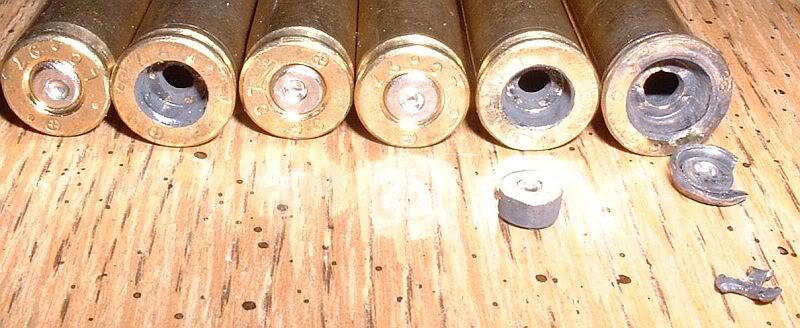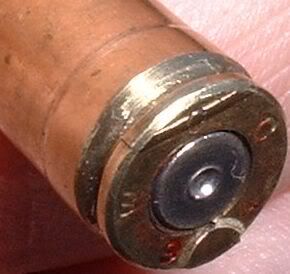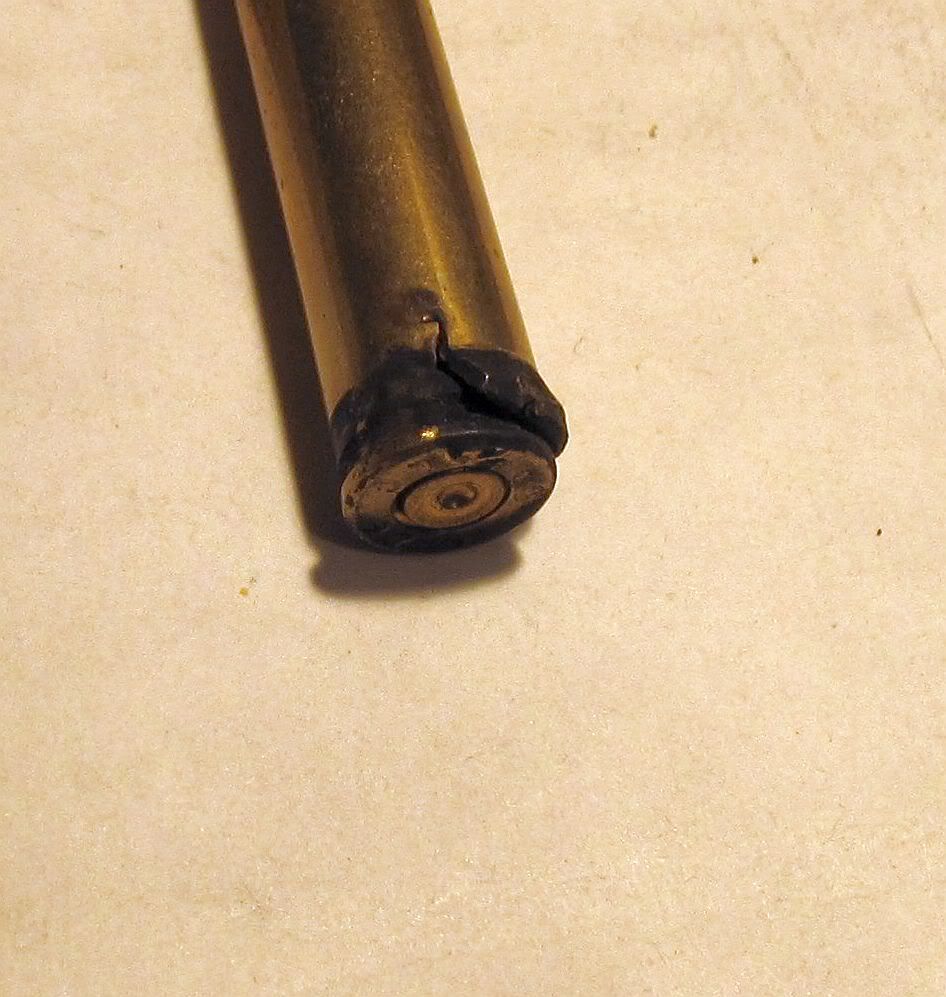Re: PSI Max
The 223 pressure limitation is the case head, getting a loose primer pocket. The threshold of loose primer pocket with one firing vs 10 firings seems to be separated by ~ 5,000 psi in Quickload predictions.
a) The 1950 designed .222 case head is good for more pressure than the 1889 7.65x53mm Mauser case head made with large Boxer primer [e.g. .308 Win].
b) The .222 case head is good for a little more than the 1925 designed 300 H&H case head [e.g. 300 Win Mag].
c) The .222 case head is not good for as much pressure as the 1978 designed small primer pocket Mauser case head in the 6mmBR.
Hodgdon website: 223 Rem, H335, 25.3 GR. 55 GR. SPR SP, 2.200", 24" barrel, 3203 fps, 49,300 CUP
Test: Ruger #1, CCI 400 small rifle primers, LC brass once fired processed from Scharch and prepped by me, 55 gr Vmax moly, H335
pic left to right: unfired, 28, 29, 30, and 31 gr.
a) unfired, extractor groove .329"
b) 28 gr, extractor groove .329", 11% overload 69 kpsi Quickload
c) 29 gr, extractor groove .329", 15% overload 80kpsi
d) 30 gr, extractor groove .3295", 19% overload 92kpsi
e) 31 gr, extractor groove .3320", 23% overload 106kpsi
This would indicate that a single time event to reach yield for the .222 case head [.223] that I tested corresponds to a Quickload estimate of between 80kpsi and 92 kpsi chamber pressure.
This question was later analyzed by Scott Sweet for me, a guy who does Von Mises for a living:
<div class="ubbcode-block"><div class="ubbcode-header">Quote:</div><div class="ubbcode-body">22 June 2004 07:43
Clark,
Here are the results of the von Mises stress calculations for the 223
Remington case head.
Using mechanical properties for C26000 brass (cartridge brass)
Temper - H06
Tensile yield strength - 65,300 psi
von Mises stress at the Primer pocket surface - 117,186 psi
von Mises stress at the Extractor OD - 65,300 psi (initiation of yielding)
Chamber pressure - 86,427 psi (Nominal properties)
Chamber pressure - 80,809 psi (minimum properties)
Chamber pressure - 92,044 psi (maximum properties)
Again these values are ONLY valid for a H06 tempered C26000 case.[Scott Sweet]</div></div>
While the testing with H335 is predictable, stable, and repeatable, the testing with Blue Dot is erratic.
Here we see a number of 223 case heads all fired with 18 gr Blue Dot 33 gr Vmax. The intact brass measured 4100 fps, and the destroyed brass measured 4200 fps. The pressure varies so much with this load that associating a single pressure with the load has no meaning.
Here we see 18 gr Blue Dot 33 gr Vmax fire in an AR15.
We see pressure signs:
1) The case head web is about to break from the body.
2) The outline of the extractor is visible on the case head.
3) The outline of the ejector is visible on the case head.
4) The primer is cratering back through the gap between firing pin and firing pin hole.
I have done long term experiments at 66kpsi with large populations of brass dedicated to a particular sizing die. Full length sized with shoulder set back that will accommodate the different headspace measurements on factory rifles makes for trimming brass every firing or ever other firing. However, 20 consecutive firings are possible with neck sizing at 66 kpsi before trimming is necessary. .223 brass shrinks too much on firing at high pressure and grows too much on FL sizing.
What does it all mean?
a) The .223 is SAMMI registered at 55k psi max average pressure and 71.5 kpsi to 77 kpsi proof pressure.
b) The cartridge is empirically and analytically has a threshold of long brass life ~ 80 kpsi and a threshold of short brass life ~ 85 kpsi.
c) Full length resizing of the brass for AR15s may preclude using the .223 at higher pressures as the trim frequency is too high.








